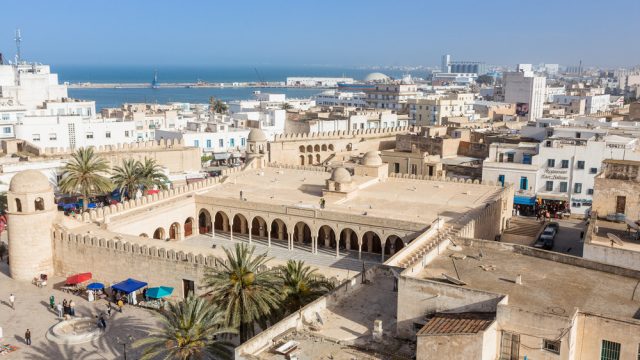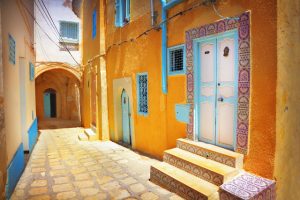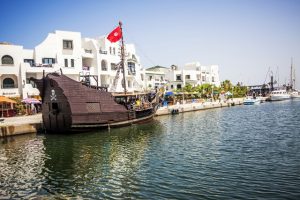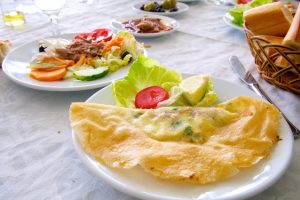Sousse is blessed with some of the best beaches in North Africa, making it a perennial favorite with Europeans seeking to get away from the chill winters. But it’s also got centuries-old architecture, a bustling medina, and excellent dining and nightlife. Still the city is often overlooked, and it is just hitting its stride as far as a tourist destination.
History and orientation
Sousse was originally settled by the Phoenicians as Hadrumetum in the 11th century BC, a colony that pre-dated Carthage. It later became one of the most important cities in the Roman territory in northern Africa because of its strategic location on the sea. It was conquered by Arabs in the 7th century, then later the Normans, the Spanish, then the French before becoming free of colonial rule in the 20th century.
Being the third-largest city in the country after Tunis and Sfax, Sousse is extremely important to the country’s economy, being home to a university, a large fishing industry, and of course tourism. In recent years, it has recorded over 1 million visitors per year, mostly those drawn in by the fantastic beaches.
Sousse is located on the northeast coast of Tunisia, halfway between Tunis and Sfax, on the Gulf of Hammamet. The white sandy beach stretches the entire length of the town (several kilometres). The ancient medina sits in the centre, with more modern areas radiating out from the medina to the north, south and east. The town is bordered to the south by the town of Monastir, which sits on a jutting peninsula, and to the north by the port of El Kantaoui.
Attractions
Like many other medinas in the Maghreb, Tunisia’s medina has been declared a UNESCO World Heritage Site. It’s pretty large and gets packed like sardines at times, full of people sweating from the heat. It’s also located in the center of town and is bordered by medieval fortifications. The commercial part of the medina is formed by the Souq er-Ribba and is full of pushy merchants, colorful fabrics, and people trying to make their way through the crowds with overloaded carts. Take the time to stroll around the streets, soak in the local sights and sounds, and pick up an item or two to take back to your hotel. If you’re a bit timid or unused to the busyness of a medina, hire a local guide to show you around.
To escape the medina for a bit of quiet, head to the Museum Dar Essid. It’s set in an old home and furnished like it was straight out of the 19th century. The house was built in 928 AD, making it one of the oldest in the medina, so it’s definitely worth checking out if you are a history or architecture buff.
Another great museum is the Sousse Archaelogical Museum in the old kasbah. It has one of the best collections of mosaics in the country and is surrounded on two sides by beautiful courtyards.
The Great Mosque is another architectural wonder and was built in 851 AD by a freed slave. While you can go up to the courtyard and observe the wonderful architecture, non-Muslims aren’t allowed beyond that point into the vaulted prayer hal. It’s rather unusual that the mosque has no minaret, probably because it’s very close to the Ribat, the most marvelous structure of the medina. It was built in 8th century and was inspired by the Byzantines. The structure was used as a watch tower to look over the city and harbor. It’s one of the best conserved “fortress-monasteries” that still remains on the coast of North Africa.
If you’re a fan of catacombs, Sousse is right up your alley — the town is home to 5.5 km (3 miles) of underground passageways, tunnels, and caverns holding the remains of thousands of Tunisian Christians from over 1500 years ago. Only 100 m (300 feet) is open to the public, but it’s still an interesting way to beat the heat and learn about the fascinating history of early Tunisia and Christianity.
Sousse also has some truly spectacular, if a little overcrowded, beaches; picture soft turquoise water, flanked by land that’s buttered with golden waves. The best stretches of beach are around the Movenpick and Marhaba Beach Hotel. Boujaffar Beach is another great choice, but gets pretty packed as it’s near a lot of cafes and restaurants, so be sure to get there early if you want to find a spot during high months. Las Vegas beach and Port El Kantaoui beach are other favorites.
Excursions
For one of the best views of the city, head to Port El Kantaoui, about 10km north of the city center. The area is geared towards tourists, but there are some cool shops in the area (even though they aren’t exactly authentic). Many of the restaurants in the area also cater to a Western palate, if you ever get tired of the traditional Tunisian cuisine back in the city. And if you want to break out the clubs, there is a 36-hole PGA golf course.
While in Port El Kantaoui, you can hire a catamaran to take you out onto the ocean for a few hours of fun sailing and relaxation. The harbor has over 300 boats, and there are always several that are willing to take you out for sailing or diving. It’s also a great place to escape the crowded areas of the beach and catch some rays while laying on the deck of the boat.
Several old cities are within easy driving distance of Sousse and make for a nice day trip. The holy city of Kairouan (about an hour away) is a great destination to tour, and the large mosque there is a UNESCO World Heritage Site. Monastir is another great trip with its own impresive Ribat. El Jem is located 70km south and features a majestic Roman amphitheater — you might recognize it, as some of the scenes from “Gladiator” were filmed there.
Dining
Meals in Sousse are relatively inexpensive for what you get, so you are sure to eat well while in the city.
Restaurant Cafe Seles is inviting with charming, light-blue doors tempting you to stroll in from the streets of the medina. The briq (fried, filled pastry) at this location is some of the best in the city, definitely a must. The cafe also specializes in fresh local fish caught right out of the gulf, highly recommended. If you’re not a seafood eater, go for the Couscous Royal with lamb, chicken and mergueze. Outside, a small and cozy terrace gives diners a great place to eat while taking in the sounds of the sights of the medina below.
While somewhat touristic, El Khella serves up amazing authentic Tunisian cuisine and overlooks the Ribat. Part of the rooftop comes off, making for a great outdoor feel in an indoor setting. The menu is not only traditional, but offers a good mix of contemporary Tunisian fare you would expect to find in somebody’s home. It also makes a great place to sit back and people watch.
For more amazing seafood with an Italian twist, try Caruso Cafe Bar. The restaurant offers massive portions of mussels, prawns and fish along with traditional Italian fare like spaghetti bolognaise, and even spaghetti africans (with pieces of steak). The restaurant has a great view of the sea with an open veranda, perfect for a casual afternoon or late-night date. If you’ve had your fare share of Tunisian cuisine on your trip and wanting a delicious break, this is definitely a spot to check out.
Where To Stay
Most of the best and newest hotels are luckily situated by the beach and within walking distance of the medina, offering the best of both worlds. Note: most hotels do not offer free wi-fi, but if you need free internet access, try one of the local cafes.
One great option on the beach is the Mövenpick Resort & Marine Spa Sousse. The hotel also offers a beautifully landscaped swimming pool with plenty of palm trees to shade you if it gets too hot. The grounds are huge and beautiful with very friendly staff to help accommodate you. It also offers a great breakfast buffet to load up on before hitting the beach or the city.
Marhaba Salem is another favorite among travelers, largely due to the on site entertainment provided by the hotel staff. The location features an indoor swimming pool to beat the heat (or chilly days in winter), a jacuzzi, sauna and masseuses to help you relax.
Families will enjoy the Tour Khalef Marhaba Thalasso & Spa. Many of the rooms have nice balconies with great views of the beach and spacious rooms for the kids to run around in, though some have rather lackluster views (be sure to get a room facing the beach or pool). The pool is nice to hang out with the family and has a nice snack bar, there’s also a tranquil garden for strolling around.
Getting There and Around
Monastir Airport (MIR) is located 17 km south of Sousse, and takes about 20 minutes to get to. A local metro rail runs every 20-30 minutes and stops just 200 meters from the airport. You can also fly into Enfidha (NBE) airport near Hammamet, though it’s a bit farther away (48 km) and transportation from there isn’t as easy to come by.
Cheap, reliable rains run frequently from Tunis to Sousse, but they are rather slow and a bit bumpy at times. If you are coming from Hammamet, the train offers a relatively scenic route through the Tunisian countryside, past olive and orange groves and small villages.
You can certainly drive into Sousse as well, but driving in Tunisia can be pretty dangerous and accidents are frequent. So unless you are experienced at driving in North Africa, this is probably not the best option.
A ferry connects Sousse with Mazara del Vallo (Sicily) three times a week. So if you’re trying to do a combination Italy-Tunisia trip, this might be a good option. In summer, a car ferry runs between Trapani (Sicily) and Sousse once a week.
It’s pretty easy to get around on foot once in Sousse, but taxis are widely available, even if they have a bit of a bad reputation. Be sure to agree on a price before you get in, as the drivers often don’t use the meters. To save on the fare a bit, take a shared taxi or minibus with others to get around and split the fare. They are popular with locals, but if you are in a hurry it can take awhile, as they don’t leave until they are full.
Practical Considerations
Languages: All Tunisians speak French and Arabic, but in touristic areas of Sousse many locals also speak fairly decent English, German, Spanish and Italian.
Weather: The city has a hot, semi-arid and slightly Mediterranean climate. Sousse has experienced temperatures of over 110F (43C) between May and September, which is the hottest season, though average highs in July average around 87F (31C). The most popular season to visit Sousse is winter, wheand 60F (16C) in January
Health and safety: The main thing to worry about in Sousse are pickpockets, who generally stick to crowded areas in the souk or Camel market. Outside of that, violent crime is practically unheard of, and the town closes down for the night pretty early. Western women often get excessive attention from men, particularly if walking alone, but it’s harmless. Just ignore it and do not make eye contact. There are various ways scammers try to get you to part with your cash, so the rule of thumb is that if an unfamiliar person approaches you and offers you a tour or deal (or pretends to know you), just say no and walk away.
There are no major health threats in Sousse, except the possibility of sunburn and heatstroke. ALWAYS carry water with you when the weather is warm, and fair-skinned people should wear hats and sunscreen, even on overcast days.
The local hospital is Clinique Les Oliviers, Boulevard 7 Novembre, Tel: +216 73 242 711.
Emergency numbers:
- Police: 197
- Ambulance: 190
- Fire brigade: 198
Money and banking: The dinar is the currency of Tunisia. You can only exchange money in Tunisia, not before you enter the country, and you can’t take any currency with you when you leave. Avoid changing money in hotels – they can charge up to 15% more than a bank. Use the bureau de change at the airport, or one of the many banks in the city centre such as Agricultural Bank of Tunisia and Societe Generale. Hotels, restaurants and larger tour companies will accept credit cards, but for smaller purchases in the souk or local shops you’ll have to use cash. Haggling is expected in the souks.
Tipping and local customs: Tunisia being a Muslim country, women are advised to cover their shoulders and legs in public areas.
More information: The Tunisian National Tourist Office






